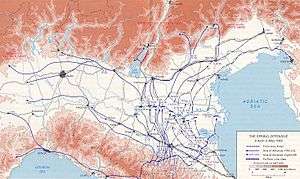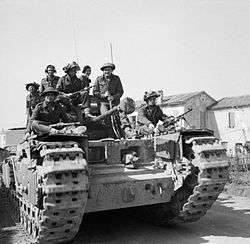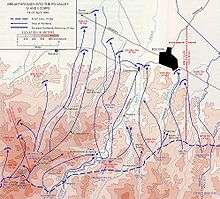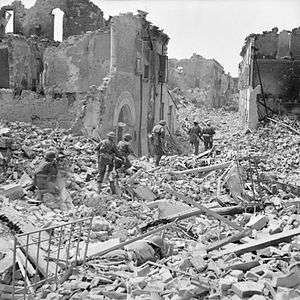Spring 1945 offensive in Italy
| ||||||||||||||||||||||||||||||
The Spring 1945 offensive in Italy, codenamed Operation Grapeshot,[5] was the final Allied attack during the Italian Campaign in the final stages of the Second World War, launched by the 15th Allied Army Group, the Plain started on 6 April 1945, ending on 2 May with the formal surrender of German forces in Italy.
Background
The Allies had launched their previous major offensive, on the Gothic Line, in August 1944 with the British Eighth Army, under Lieutenant-General Oliver Leese, attacking up the coastal plain of the Adriatic and the U.S. Fifth Army, led by Lieutenant General Mark Clark, attacking through the central Apennine Mountains. Although they managed to breach the formidable Gothic Line defences, they narrowly failed to break out into the Po Valley before the winter weather closed in and made further progress impossible. Their forward formations spent the rest of the winter in highly inhospitable conditions while preparations were made to renew the campaign when better conditions returned in the spring.
Command changes
When Field Marshal Sir John Dill, the head of the British Mission in Washington, died on 5 November, Field Marshal Sir Maitland Wilson was appointed his replacement. General Harold Alexander, having been promoted to Field Marshal, was in turn appointed to replace Wilson as Allied Supreme Commander Mediterranean on 12 December. Lieutenant General Mark Clark succeeded Alexander as commander of the Allied forces in Italy (renamed 15th Army Group) but without promotion. Lieutenant General Lucian K. Truscott had been commanding U.S. VI Corps from its time in the beachhead at Anzio and the capture of Rome to its current location in Alsace, having landed in the South of France during Operation Dragoon. He returned to Italy to assume command of U.S. Fifth Army.
Command changes also took place in the German army before the spring campaign. On 23 March Albert Kesselring was appointed Commander-in-Chief Army Group West, replacing General-Field Marshal Gerd von Rundstedt. Heinrich von Vietinghoff returned from the Baltic to take over from Kesselring while Traugott Herr, the experienced commander of German 10th Army's LXXVI Panzer Corps, took over 10th Army. Joachim Lemelsen, who had had temporary command of the 10th Army, returned to the command of the 14th Army.
Orders of battle
Looking ahead to the spring, the problems of manning continued. In October 1944, 4th Indian Infantry Division had been sent to Greece and British 4th Infantry Division had followed them in November as well as 139th Brigade of British 46th Infantry Division, with the rest of the 46th following in December along with the 3rd Greek Mountain Brigade. In early January 1945 the British 1st British Division was sent to Palestine. At the end of January 1945, I Canadian Corps and British 5th Infantry Division were ordered to North West Europe, reducing Lieutenant-General Richard McCreery's Eighth Army to 7 divisions. Two other divisions, both British, were to follow them to Europe, but Alexander argued for these to instead remain in Italy.
On the positive side, however, the Fifth Army had been reinforced from September to November 1944 with the arrival of fresh troops of 1st Brazilian Division and in January 1945 with the specially trained and equipped U.S. 10th Mountain Division.[6] Allied strength amounted to 17 divisions plus 8 independent brigades (including four Italian groups of volunteers from the Italian Co-Belligerent Army, equipped and trained by the British), a total equivalent of just under 20 divisions. 15th Army Group's total headcount amounted to 1,334,000 men[7] with Eighth Army's effective fighting strength totalling 632,980 men[2] and Fifth Army 266,883.[7] Against them were ranged 21 much weaker German divisions and 4 Italian ENR divisions, a total of 25.[8] Three of the Italian divisions were allocated to the Ligurian Army under Rodolfo Graziani guarding the western flank facing France and the fourth to 14th Army in a sector thought least likely to be attacked.[9]
Plan of attack

Clark set out his battle plan on 18 March. Its objective was "...to destroy the maximum number of enemy forces south of the Po, force crossings of the Po and capture Verona."[10] In Phase I the British Eighth Army would successively cross the Senio and Santerno rivers and then make a dual thrust, one towards Budrio parallel to the Bologna road, Route 9 (the Via Emilia) and the other north west along Route 16, the Via Adriatica, towards Bastia and the Argenta Gap, a narrow strip of dry terrain through the flooded land west of Lake Comacchio. An amphibious operation across the lake and parachute drop would bring pressure to bear on the flank and help to break the Argenta position. Depending on the relative success of these actions a decision would be made on whether Eighth Army's prime objective would become Ferrara, on the Via Adriatica, or remain Budrio. Meanwhile, it was intended for U.S. Fifth Army to launch the Army Group's main effort at 24 hours notice from two days after Eighth Army's attack and break into the Po valley. The capture of Bologna was given as a secondary task.[10]
In Phase II, the Eighth Army was to drive north west to capture Ferrara and Bondeno, blocking routes of potential retreat across the Po. U.S. Fifth Army was to push past Bologna north to link with Eighth Army in the Bondeno region to complete an encirclement of German forces south of the Po. The Fifth Army was also to make a secondary thrust further west towards Ostiglia, the crossing point on the Po of the main route to Verona.[11] Phase III involved the establishment of bridgeheads across the Po and exploitation north.
The Eighth Army plan (Operation Buckland) had to deal with the difficult initial task of getting across the Senio, with its raised artificial banks varying between 6 metres (20 ft) and 12 m (40 ft) in height, honeycombed with defensive tunnels and bunkers front and rear. V Corps were ordered to make an attack on the salient formed by the river into the Allied line at Cotignola. On the right of the river's salient was 8th Indian Infantry Division, reprising the role they played crossing the Rapido in the final Battle of Monte Cassino. To the left of the 8th Indian Division, on the left of the salient, the 2nd New Zealand Division would attack across the river to form a pincer. To the left of V Corps, on Route 9, the Polish II Corps would widen the front further by attacking across the Senio towards Bologna. The Poles had been desperately under strength in the autumn of 1944, but had received 11,000 reinforcements during the early months of 1945, mainly from Polish conscripts in the German Army taken prisoner in the Battle of Normandy the previous summer .[12]
Once across the Senio the assault divisions were to advance to cross the Santerno. Once the Santerno was crossed, British 78th Division would also reprise their Cassino role and pass through the bridgehead established by the Indians and New Zealanders and drive for Bastia and the Argenta gap, 23 kilometres (14 mi) behind the Senio, where the dry land narrowed to a front of only 5 km (3 mi), bounded on the right by Lake Comacchio, a huge lagoon running to the Adriatic coast, and on the left by marshland. At the same time British 56th Division would launch the amphibious flank attack along Lake Comacchio. On V Corps' left flank the New Zealand Division would advance to the left of the marshland on the west side of Argenta while the Indian Division would pass in Army Reserve.[13]
The Fifth Army plan (Operation Craftsman) envisaged an initial thrust by IV Corps along Route 64 to straighten the army front and to draw German reserves away from Route 65. II Corps would then attack along Route 65 towards Bologna. The weight of the attack would then switch westward again to break into the Po valley skirting Bologna.[14]
Battle
In the first week of April, diversionary attacks were launched on the extreme right and left of the Allied front to draw German reserves away from the main assaults to come. This included Operation Roast, an assault by British 2nd Commando Brigade and armour to capture the seaward isthmus of land bordering Lake Comacchio and seize Port Garibaldi on the lake's north side. Meanwhile, damage to other transport infrastructure having forced Axis forces to use sea, canal and river routes for re-supply, Axis shipping was being attacked in bombing raids such as Operation Bowler.

The build-up to the main assault started on 6 April with a heavy artillery bombardment of the Senio defenses. In the early afternoon of 9 April, 825 heavy bombers dropped fragmentation bombs on the support zone behind the Senio followed by medium and fighter bombers. From 15:20 to 19:10, five heavy artillery barrages were fired, each lasting 30 minutes, interspersed with fighter bomber attacks. In support of the New Zealand operations, 28 Churchill Crocodiles and 127 Wasp flamethrower vehicles were deployed along the front.[15][16] The 8th Indian Division, 2nd New Zealand Division and 3rd Carpathian Division (on the Polish Corps front at Route 9) attacked at dusk. In fighting in which there were two Victoria Crosses won by 8th Indian Division members, they had reached the river Santerno, 5.6 km (3.5 mi) beyond, by dawn on 11 April. The New Zealanders had reached the Santerno at nightfall on 10 April and succeeded in making a crossing at dawn on 11 April. The Poles had closed on the Santerno by the night of 11 April.[17]
By late morning of 12 April, after an all night assault, the 8th Indian Division was established on the far side of the Santerno and the British 78th Division started to pass through to make the assault on Argenta. In the meantime the British 24th Guards Brigade, part of 56th (London) Infantry Division, had launched an amphibious flanking attack from the water and mud to the right of the Argenta Gap. Although they gained a foothold, they were still held up at positions on the Fossa Marina on the night of 14 April. 78th Battleaxe Division was also held up on the same day on the Reno River at Bastia.

The U.S. 5th Army began its assault on 14 April after a bombardment by 2,000 heavy bombers and 2,000 artillery pieces, with attacks by the troops of U.S. IV Corps (1st Brazilian, 10th Mountain, and 1st Armored Divisions) on the left. This was followed on the night of 15 April by U.S. II Corps striking with 6th South African Armoured and 88th Infantry Divisions advancing towards Bologna between Highway 64 and 65, and 91st and 34th Infantry Divisions along Highway 65.[18] Progress against a determined German defence was slow but ultimately superior Allied firepower and lack of German reserves told and by 20 April both corps had broken through the mountain defences and reached the plains of the Po valley. 10th Mountain Division were directed to bypass Bologna on their right and push north leaving U.S. II Corps to deal with Bologna along with Eighth Army units advancing from their right.[19]
By 19 April, on the Eighth Army front, the Argenta Gap had been forced, and British 6th Armoured Division was released through the left wing of the advancing 78th Division to swing left to race north west along the line of the river Reno to Bondeno and link up with the US 5th Army to complete the encirclement of the German armies defending Bologna.[20] On all fronts the German defense continued to be determined and effective, but Bondeno was captured on 23 April. The 6th Armoured Division linked with US IV Corps' 10th Mountain Division the next day at Finale some 5 miles (8.0 km) upstream along the river Panaro from Bondeno. Bologna was entered in the morning of 21 April by the Eighth Army's Polish II Corps' 3rd Carpathian Infantry Division advancing up the line of Route 9, followed two hours later by US II Corps from the south.[21]
U.S. IV Corps had continued their northwards advance and reached the river Po at San Benedetto on 22 April. The river was crossed the next day, and they advanced north to Verona which they entered on 26 April. To the right of Fifth Army on Eighth Army's left wing, British XIII Corps crossed the Po at Ficarolo on 22 April, while V Corps were crossing the Po by 25 April, heading towards the Venetian Line, a defensive line built behind the line of the river Adige. As Allied forces pushed across the Po, on the left flank the Brazilian, 34th Infantry and 1st Armored Divisions of IV Corps were pushed west and northwest along the line of Highway 9 towards Piacenza and across the Po to seal possible escape routes into Austria and Switzerland via Lake Garda.[22][23] On 27 April, the 1st Armored Division liberated Milan, and IV Corps commander Crittenberger entered the city on 30 April. To the south of Milan, at Collechio-Fornovo, the Brazilian Division bottled up the remaining effectives of two German divisions along with the last units of fascist army, taking on 28 April 13,500 prisoners.[24]
On the Allied far right flank, British V Corps, met by lessening resistance, traversed the Venetian Line and entered Padua in the early hours of 29 April, to find that partisans had locked up the German garrison of 5,000.[25]
Aftermath
Secret surrender negotiations between representatives of the Germans and Western Allies had taken place in Switzerland (Operation Crossword) in March but had resulted only in protests from the Russians that the Western Allies were attempting to negotiate a separate peace.
On 28 April, von Vietinghoff sent emissaries to Allied Army headquarters. On 29 April, they signed an instrument of surrender to the effect that hostilities would formally end on 2 May.[25] Confirmation from von Vietinghoff of the arrangements did not reach Allied 15th Army Group headquarters until the morning of 2 May. It emerged that Kesselring had had his authority as Commander of the West extended to include Italy and had replaced von Vietinghoff with General Friedrich Schulz from Army Group G on hearing of the plans. However, after a period of confusion during which the news of Hitler's death arrived, Schulz obtained Kesselring's agreement to the surrender and von Vietinghoff was reinstated to see it through.[26]
See also
Notes
- Footnotes
- ↑ Total army group strength including Lines of Communication and support troops totalled 1,333,856[1]
- ↑ In addition the army group had 91,000 Lines of Communication and anti-aircraft troops and controlled a further 100,000 local police[3]
- ↑ From 9 April 1945 until the end of Operation Grapeshot, thus casualties exclude those suffered during the preliminary operations.
5th Army: 7,965 casualties. American: 6,834 (1,288 killed, 5,453 wounded and 93 missing) casualties; South African: 537 (89 killed, 445 wounded and 3 missing) casualties; Brazilian: 594 (65 killed, 482 wounded and 47 missing) casualties.
8th Army: 7,193 casualties. British: 3,068 (708 killed, 2,258 wounded and 102 missing) casualties; New Zealand: 1,381 (241 killed and 1,140 wounded) casualties; Indian: 1,076 (198 killed, 863 wounded and 15 missing) casualties; Colonial: 46 (11 killed and 35 wounded) casualties; Polish: 1,622 (260 killed, 1,355 wounded and 7 missing) casualties.
Italians fighting with both armies: 1,100 (242 killed, 828 wounded and 30 missing) casualties.[4] - ↑ British estimated around 30,000 casualties were inflicted upon the Axis forces during this offensive, while a German staff officer estimated 32,000 casualties suffered during Operation Grapeshot.[4]
- Citations
- 1 2 Jackson, p. 230.
- 1 2 Jackson, p. 223.
- 1 2 Jackson, p. 236.
- 1 2 3 Jackson, p. 334
- ↑ Jackson, p. 253
- ↑ Clark, 1950 p.607-09
- 1 2 Jackson, p.230.
- ↑ Blaxland, p242
- ↑ Blaxland, p243
- 1 2 Jackson, p. 203.
- ↑ Jackson, p. 204.
- ↑ Blaxland, p247
- ↑ Jackson, p. 225.
- ↑ Jackson, p. 228.
- ↑ Fletcher, Churchill Crocodile p35
- ↑ approximately one flamethrower vehicle every 64 metres along an 8 km long front
- ↑ Blaxland, pp256-258
- ↑ Popa, pp. 10–12
- ↑ Popa, p. 15
- ↑ Blaxland, pp. 267-8
- ↑ Blaxland, p. 271
- ↑ Evans, Chapter 14 View on Google Books.
- ↑ Popa, p. 20
- ↑ Popa, p. 23
- 1 2 Blaxland, p277
- ↑ Blaxland. pp279-80
References
- Blaxland, Gregory (1979). Alexander's Generals (the Italian Campaign 1944-1945). London: William Kimber & Co. ISBN 0-7183-0386-5.
- Böhmler, Rudolf (1964). Monte Cassino: a German View. London: Cassell. OCLC 2752844.
- Carver, Field Marshal Lord (2001). The Imperial War Museum Book of the War in Italy 1943-1945. London: Sidgwick & Jackson. ISBN 0-330-48230-0.
- Clark, Mark (2007) [1950]. Calculated Risk. Enigma Books. ISBN 9781929631599.
- Doherty, Richard (2014). Victory in Italy: 15th Army Group's Final Campaign 1945. Pen & Sword Books Ltd. ISBN 9781783462988.
- Evans, Bryn (2012) [1988]. With the East Surreys in Tunisia and Italy 1942 - 1945: Fighting for Every River and Mountain. The Rosen Publishing Group, Inc. ISBN 9781848847620.
- Hingston, W.G. (1946). The Tiger Triumphs: The Story of Three Great Divisions in Italy. HMSO for the Government of India. OCLC 29051302.
- Jackson, General W.G.F.; with Gleave, Group Captain T.P. (2004) [1st. pub. HMSO 1988]. Butler, Sir James, ed. The Mediterranean and Middle East, Volume VI: Part III - November 1944 to May 1945. History of the Second World War United Kingdom Military Series. Uckfield, UK: Naval & Military Press. ISBN 1-84574-072-6.
- Laurie, Clayton D. (c. 1990). Rome-Arno 22 January-9 September 1944. WWII Campaigns. Washington DC: United States Army Center of Military History. CMH Pub 72-20.
- Muhm, Gerhard. "German Tactics in the Italian Campaign".
- Muhm, Gerhard (1993). La Tattica tedesca nella Campagna d'Italia, in Linea Gotica avanposto dei Balcani (in Italian) (Edizioni Civitas ed.). Roma: (Hrsg.) Amedeo Montemaggi.
- Oland, Dwight D. (1996). North Apennines 1944-1945. WWII Campaigns. Washington DC: United States Army Center of Military History. CMH Pub 72-34.
- Orgill, Douglas (1967). The Gothic Line (The Autumn Campaign in Italy 1944). London: Heinemann.
- Popa, Thomas A. (1996). Po Valley 1945. WWII Campaigns. United States Army Center of Military History. ISBN 0-16-048134-1. CMH Pub 72-33.
External links
| Wikimedia Commons has media related to Spring 1945 offensive in Italy. |
